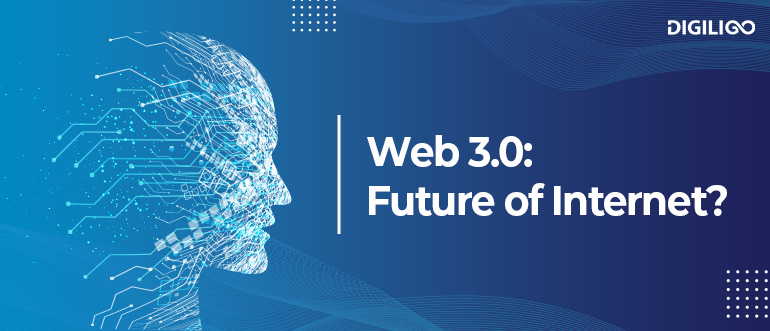The internet generation in which websites and apps can process information in a more human-like or intelligent manner. They will be intelligent thanks to technologies such as Artificial Intelligence (AI), Big Data, Blockchain, and Machine Learning (ML).
Web 3.0 is distinguished by openness, accessibility, incredible user utility, democratisation, and decentralization. When researching Web 3.0 technology, there are a few details to keep in mind. First and foremost, the concept is not novel. Back in 2006, Jeffrey Zeldman, one of the early developers of Web 1.0 and 2.0 applications, wrote a blog post expressing his support for Web 3.0. Discussions on the subject, however, began as early as 2001.
What is Web 3.0?
Web 3.0 is the Internet’s third iteration, which interconnects data in a decentralised manner to provide a faster and more personalised user experience. It is built with artificial intelligence, machine learning, and the semantic web in mind, and it employs the blockchain security system to keep your data safe and secure.
Users and machines will also be able to interact with data. However, for this to happen, programmes must comprehend information conceptually as well as contextually. Keeping this in mind, the semantic web and artificial intelligence are the two cornerstones of Web 3.0.
Difference Between Web 1.0, Web 2.0, And Web 3.0
Web 1.0 (1989-2005):
Web 1.0 refers to the first stage of the evolution of the World Wide Web. In Web 1.0, there were few content creators, with the vast majority of users being content consumers. Personal web pages were common, with static pages hosted on ISP-managed web servers or free web hosting services.
Web 1.0 is a content delivery network (CDN) that allows websites to display information. It is appropriate for use as a personal website. The amount charged to the user is determined by the number of pages viewed. It includes directories where users can search for specific information.
Web 2.0 (1999-2012):
Web 2.0 refers to websites around the world that emphasise user-generated content, usability, and interoperability for end users. It does not refer to a change in any technical specifications, but rather to a change in the way Web pages are designed and used.
The transition is beneficial, but it does not appear to be the case when the changes take place. Web 2.0 allows interaction and collaboration with one another in a social media dialogue as the creator of user-generated content in a virtual community.
The three core layers of innovation that drove the emergence of web 2.0 were:
- Mobile
- Social
- Cloud
Web 3.0 (2006-ongoing):
It refers to the evolution of web usage and interaction, including the conversion of the Internet into a database. After a long period of focusing on the front-end, it allows the web’s back-end to be upgraded (Web 2.0 has mainly been about AJAX, tagging, and another front-end user-experience innovation).
Web 3.0 is a term that refers to several stages in the evolution of web usage and interaction. In this case, data is shared rather than owned, with different services displaying different views for the same web/data.
Now let’s talk about the Features of Web 3.0.
Semantic Web:
The Semantic Web is the next step in the Internet’s evolution. The semantic web improves on-demand web technologies for creating, sharing, and connecting content through search and analysis based on the ability to comprehend the meaning of words rather than keywords or numbers.
Artificial Intelligence:
Using this capability in conjunction with natural language processing, computers in Web 3.0 can distinguish information like humans to provide faster and more relevant results. They become more intelligent to meet the needs of users.
3D Graphics:
Web 3.0 websites and services make extensive use of three-dimensional design. Museum guides, computer games, e-commerce, and geospatial applications are all examples of where 3D graphics are used.
Connectivity:
Because of semantic metadata, information is more connected in Web 3.0. As a result, the user experience evolves to a higher level of connectivity that makes use of all available data.
Ubiquity:
Multiple applications can access the content, every device is connected to the internet, and the services can be used anywhere.
What are the layers of web 3.0?
Whereas web 2.0 was driven primarily by the introduction of mobile, social, and cloud technologies, web 3.0 is propelled by four layers of technological innovation:
Edge Computing:
While data centres modified currently commoditized personal computer technology during web 2.0, the transition to web 3.0 is pushing the data centre out to the edge, and sometimes right into our hands.
Data centres are supplemented by a slew of advanced computing resources dispersed across phones, laptops, appliances, sensors, and automobiles, which will generate and consume 160 times more data in 2025 than in 2010.
Decentralized Data Network:
Decentralized data networks allow different data generators to sell or trade their data without losing ownership, jeopardising privacy, or relying on intermediaries. As a result, in the growing ‘data economy,’ decentralised data networks will have a long list of data providers.
Artificial Intelligence & Machine Learning:
It has grown powerful enough to make useful, even life-saving, predictions and actions. When layered on top of new decentralised data structures that provide access to a wealth of data that today’s tech titans would envy, the potential applications extend far beyond targeted advertising into areas such as precision materials, drug design, and climate modelling.
Blockchain:
In layman’s terms, blockchain is an additional layer of technology that sits behind web 3.0. More specifically, blockchain is the foundation of web3, as it redefines data structures in the semantic web’s backend.
Blockchain is a decentralised state machine that allows for the deployment of intelligent contracts. These smart contracts define the logic of a web 3.0 application. As a result, anyone wishing to create a blockchain application must deploy their application code on the shared state machine.



